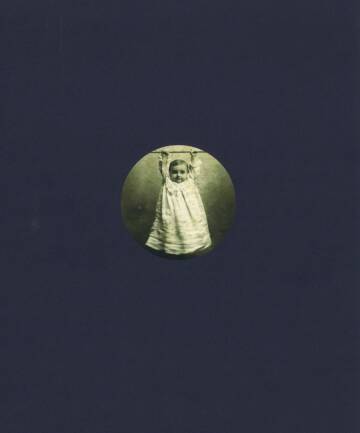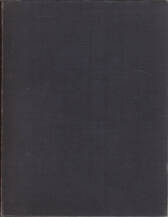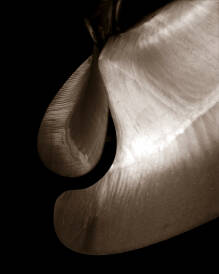The Hidden Mother
by Linda Fregni Nagler
Photographs: Linda Fregni Nagler
Text: Massimiliano Gioni, Geoffrey Batchen and a conversation between Francesco Zanot and Linda Fregni Nagler
Publisher: MACK Books Co-published with the Nouveau Musée National de Monaco
432 pages
Pictures: 1002 colour plates
Year: 2013
ISBN: 978-1-907946-53-0
Comments: 23.8 cm x 28.6 cm, softcover with a die cut dustjacket
In the vein of Francis Alÿs’s Fabiola and Andy Warhol’s Time Capsules, Linda Fregni Nagler has collected seemingly nondescript images and accumulated a meaningful archive, thereby giving them a renewed purpose and intensity.
The Hidden Mother is comprised of 1,002 photographs (from daguerreotypes and tintypes to cartes de visite and cabinet cards), all examples of a now redundant practice: to cloak or hide a parent within the background of a child’s portrait, a common procedure from the advent of photography up until the 1920s, when exposure times were relative slow, and a hidden parent was required to hold the child still.
These hidden mothers can be discerned in the background of every one of these portraits – looming behind their children, swaddled in blankets, carpets and brocades as they support their progeny as the central subject. The iterations vary, and in some instances the hidden mother is revealed as a single hand, while in others the child is seated on a shrouded figure, or the parent is quite literally hiding – ensuring that the child’s identity is transposed over their own.
The images hold a certain degree of comedy – albeit unintentional – because the viewer is asked to suspend their disbelief, to ‘not see’ the hidden figure. Some contemporary onlookers would have simply not seen the portrait’s hidden mother, indicative of the cultural nature of the act of seeing. For other viewers, the hidden figure was an essential part of the picture: high infant mortality rates meant that posthumous portraits were the norm, and thus the hidden mother would signify to the viewer that this child was alive.
Creating and defining a sub-genre of photography, Fregni Nagler has accumulated images that repeat a particular gesture – the negation of the parent in the interest of the legibility of the child. The many themes bubbling under the surface of her collection are unified by the singular principle of effacement – as if this gesture speaks of the nature of parenthood itself, or of women’s place in a patriarchal society, where she is figured without an identity of her own.
The collection also confronts the inevitable self-effacing nature of the photographer and the collector. The artist herself seems to hover over these images like a mother – conserving and safeguarding these photographs; as collector, presenter and curator of the collection, Fregni Nagler herself becomes another hidden mother.
more books tagged »Swedish« | >> see all
-
La Residence
by JH Engström
Euro 58 -
3x3 Eksjö, Hjo, Nora (last copy)
by Lars Tunbjörk, Pieter Ten Hoopen, Elin Berge
Euro 65 -
Tokyo (signed - last copy)
by Gerry Johansson
sold out -
Bristningar
by Katinka Goldberg
Euro 44 -
Photography 227 Months
by Cecilia Edefalk
Euro 44 -
Go to Become (signed)
by Jörgen Axelvall
Euro 62
more books tagged »children« | >> see all
-
This World of Dew (signed)
by Aini Hasina Bano, Chandan Gomes
sold out -
Tundra Kids (book + 2 prints)
by Ikuru Kuwajima
Euro 100 -
Youth of the Island Field (signed)
by Tamara Eckhardt
sold out -
Reading Raymond Carver (last copy)
by Mary Frey
sold out -
At the Edge of the World (signed)
by Alain Laboile
sold out -
Son
by Christopher Anderson
sold out
more books tagged »archive« | >> see all
-
Schönheit im Olympischen Kampf
by Leni Riefenstahl
Euro 2200 -
Fabrik
by Jack Tuggener
Euro 66.90 -
Until Death Do Us Part
by Thomas Sauvin
sold out -
ANATOPÉES (signed)
by Arnaud Lesage
sold out -
Berlin Mai 1945
by Valery Faminsky
Euro 52 -
Se buscan. Retratos inéditos de Manuel Álvarez Bravo
by Archivo Manuel Álvarez Bravo
Euro 49
more books tagged »portrait« | >> see all
-
One Picture Book 75: Honk If You Love Stieglitz: Jerry Uelsman...
by Stu Levy
Euro 69 -
Code Unknown
by Satoshi Fujiwara
Euro 47 -
Economopoulos, photographer
by Nikos Economopoulos
sold out -
Japan Coast (last copy)
by Silva Bingaz
Euro 38 -
Domesticas
by Andrej Balco
Euro 20 -
An Atlas of War and Tourism in the Caucasus 'This is the new f...
by Rob Hornstra
Euro 55
Random selection from the Virtual bookshelf josefchladek.com
The Hidden Mother
by Linda Fregni Nagler
Photographs: Linda Fregni Nagler
Text: Massimiliano Gioni, Geoffrey Batchen and a conversation between Francesco Zanot and Linda Fregni Nagler
Publisher: MACK Books Co-published with the Nouveau Musée National de Monaco
432 pages
Pictures: 1002 colour plates
Year: 2013
ISBN: 978-1-907946-53-0
Comments: 23.8 cm x 28.6 cm, softcover with a die cut dustjacket
In the vein of Francis Alÿs’s Fabiola and Andy Warhol’s Time Capsules, Linda Fregni Nagler has collected seemingly nondescript images and accumulated a meaningful archive, thereby giving them a renewed purpose and intensity.
The Hidden Mother is comprised of 1,002 photographs (from daguerreotypes and tintypes to cartes de visite and cabinet cards), all examples of a now redundant practice: to cloak or hide a parent within the background of a child’s portrait, a common procedure from the advent of photography up until the 1920s, when exposure times were relative slow, and a hidden parent was required to hold the child still.
These hidden mothers can be discerned in the background of every one of these portraits – looming behind their children, swaddled in blankets, carpets and brocades as they support their progeny as the central subject. The iterations vary, and in some instances the hidden mother is revealed as a single hand, while in others the child is seated on a shrouded figure, or the parent is quite literally hiding – ensuring that the child’s identity is transposed over their own.
The images hold a certain degree of comedy – albeit unintentional – because the viewer is asked to suspend their disbelief, to ‘not see’ the hidden figure. Some contemporary onlookers would have simply not seen the portrait’s hidden mother, indicative of the cultural nature of the act of seeing. For other viewers, the hidden figure was an essential part of the picture: high infant mortality rates meant that posthumous portraits were the norm, and thus the hidden mother would signify to the viewer that this child was alive.
Creating and defining a sub-genre of photography, Fregni Nagler has accumulated images that repeat a particular gesture – the negation of the parent in the interest of the legibility of the child. The many themes bubbling under the surface of her collection are unified by the singular principle of effacement – as if this gesture speaks of the nature of parenthood itself, or of women’s place in a patriarchal society, where she is figured without an identity of her own.
The collection also confronts the inevitable self-effacing nature of the photographer and the collector. The artist herself seems to hover over these images like a mother – conserving and safeguarding these photographs; as collector, presenter and curator of the collection, Fregni Nagler herself becomes another hidden mother.
more books tagged »Swedish« | >> see all
-
La Residence
by JH Engström
Euro 58 -
3x3 Eksjö, Hjo, Nora (last copy)
by Lars Tunbjörk, Pieter Ten Hoopen, Elin Berge
Euro 65 -
Tokyo (signed - last copy)
by Gerry Johansson
sold out -
Bristningar
by Katinka Goldberg
Euro 44 -
Photography 227 Months
by Cecilia Edefalk
Euro 44 -
Go to Become (signed)
by Jörgen Axelvall
Euro 62
more books tagged »children« | >> see all
-
This World of Dew (signed)
by Aini Hasina Bano, Chandan Gomes
sold out -
Tundra Kids (book + 2 prints)
by Ikuru Kuwajima
Euro 100 -
Youth of the Island Field (signed)
by Tamara Eckhardt
sold out -
Reading Raymond Carver (last copy)
by Mary Frey
sold out -
At the Edge of the World (signed)
by Alain Laboile
sold out -
Son
by Christopher Anderson
sold out
more books tagged »archive« | >> see all
-
Schönheit im Olympischen Kampf
by Leni Riefenstahl
Euro 2200 -
Fabrik
by Jack Tuggener
Euro 66.90 -
Until Death Do Us Part
by Thomas Sauvin
sold out -
ANATOPÉES (signed)
by Arnaud Lesage
sold out -
Berlin Mai 1945
by Valery Faminsky
Euro 52 -
Se buscan. Retratos inéditos de Manuel Álvarez Bravo
by Archivo Manuel Álvarez Bravo
Euro 49
more books tagged »portrait« | >> see all
-
One Picture Book 75: Honk If You Love Stieglitz: Jerry Uelsman...
by Stu Levy
Euro 69 -
Code Unknown
by Satoshi Fujiwara
Euro 47 -
Economopoulos, photographer
by Nikos Economopoulos
sold out -
Japan Coast (last copy)
by Silva Bingaz
Euro 38 -
Domesticas
by Andrej Balco
Euro 20 -
An Atlas of War and Tourism in the Caucasus 'This is the new f...
by Rob Hornstra
Euro 55
Random selection from the Virtual bookshelf josefchladek.com
The Hidden Mother
by Linda Fregni Nagler
Photographs: Linda Fregni Nagler
Text: Massimiliano Gioni, Geoffrey Batchen and a conversation between Francesco Zanot and Linda Fregni Nagler
Publisher: MACK Books Co-published with the Nouveau Musée National de Monaco
432 pages
Pictures: 1002 colour plates
Year: 2013
ISBN: 978-1-907946-53-0
Comments: 23.8 cm x 28.6 cm, softcover with a die cut dustjacket
In the vein of Francis Alÿs’s Fabiola and Andy Warhol’s Time Capsules, Linda Fregni Nagler has collected seemingly nondescript images and accumulated a meaningful archive, thereby giving them a renewed purpose and intensity.
The Hidden Mother is comprised of 1,002 photographs (from daguerreotypes and tintypes to cartes de visite and cabinet cards), all examples of a now redundant practice: to cloak or hide a parent within the background of a child’s portrait, a common procedure from the advent of photography up until the 1920s, when exposure times were relative slow, and a hidden parent was required to hold the child still.
These hidden mothers can be discerned in the background of every one of these portraits – looming behind their children, swaddled in blankets, carpets and brocades as they support their progeny as the central subject. The iterations vary, and in some instances the hidden mother is revealed as a single hand, while in others the child is seated on a shrouded figure, or the parent is quite literally hiding – ensuring that the child’s identity is transposed over their own.
The images hold a certain degree of comedy – albeit unintentional – because the viewer is asked to suspend their disbelief, to ‘not see’ the hidden figure. Some contemporary onlookers would have simply not seen the portrait’s hidden mother, indicative of the cultural nature of the act of seeing. For other viewers, the hidden figure was an essential part of the picture: high infant mortality rates meant that posthumous portraits were the norm, and thus the hidden mother would signify to the viewer that this child was alive.
Creating and defining a sub-genre of photography, Fregni Nagler has accumulated images that repeat a particular gesture – the negation of the parent in the interest of the legibility of the child. The many themes bubbling under the surface of her collection are unified by the singular principle of effacement – as if this gesture speaks of the nature of parenthood itself, or of women’s place in a patriarchal society, where she is figured without an identity of her own.
The collection also confronts the inevitable self-effacing nature of the photographer and the collector. The artist herself seems to hover over these images like a mother – conserving and safeguarding these photographs; as collector, presenter and curator of the collection, Fregni Nagler herself becomes another hidden mother.
more books tagged »Swedish« | >> see all
-
La Residence
by JH Engström
Euro 58 -
3x3 Eksjö, Hjo, Nora (last copy)
by Lars Tunbjörk, Pieter Ten Hoopen, Elin Berge
Euro 65 -
Tokyo (signed - last copy)
by Gerry Johansson
sold out -
Bristningar
by Katinka Goldberg
Euro 44 -
Photography 227 Months
by Cecilia Edefalk
Euro 44 -
Go to Become (signed)
by Jörgen Axelvall
Euro 62
more books tagged »children« | >> see all
-
This World of Dew (signed)
by Aini Hasina Bano, Chandan Gomes
sold out -
Tundra Kids (book + 2 prints)
by Ikuru Kuwajima
Euro 100 -
Youth of the Island Field (signed)
by Tamara Eckhardt
sold out -
Reading Raymond Carver (last copy)
by Mary Frey
sold out -
At the Edge of the World (signed)
by Alain Laboile
sold out -
Son
by Christopher Anderson
sold out
more books tagged »archive« | >> see all
-
Schönheit im Olympischen Kampf
by Leni Riefenstahl
Euro 2200 -
Fabrik
by Jack Tuggener
Euro 66.90 -
Until Death Do Us Part
by Thomas Sauvin
sold out -
ANATOPÉES (signed)
by Arnaud Lesage
sold out -
Berlin Mai 1945
by Valery Faminsky
Euro 52 -
Se buscan. Retratos inéditos de Manuel Álvarez Bravo
by Archivo Manuel Álvarez Bravo
Euro 49
more books tagged »portrait« | >> see all
-
One Picture Book 75: Honk If You Love Stieglitz: Jerry Uelsman...
by Stu Levy
Euro 69 -
Code Unknown
by Satoshi Fujiwara
Euro 47 -
Economopoulos, photographer
by Nikos Economopoulos
sold out -
Japan Coast (last copy)
by Silva Bingaz
Euro 38 -
Domesticas
by Andrej Balco
Euro 20 -
An Atlas of War and Tourism in the Caucasus 'This is the new f...
by Rob Hornstra
Euro 55
Random selection from the Virtual bookshelf josefchladek.com




































;jpg?c=f403c532630ba6dd8d73401caf83273f)
;jpg?c=c24c2678df6d00cdab58588a39a4cc77)





;jpg?c=200f63648ea7b2cb994afa4cb65b2f0c)




;jpg?c=8e03d10a03fa1b04c2ec5bad8cebd48b)
